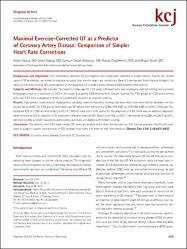| dc.contributor.author | Akyüz, Aydın | |
| dc.contributor.author | Alpsoy, Şeref | |
| dc.contributor.author | Akkoyun, Dursun Çayan | |
| dc.contributor.author | Değirmenci, Hasan | |
| dc.contributor.author | Güler, Niyazi | |
| dc.date.accessioned | 2022-05-11T14:40:07Z | |
| dc.date.available | 2022-05-11T14:40:07Z | |
| dc.date.issued | 2013 | |
| dc.identifier.issn | 1738-5520 | |
| dc.identifier.issn | 1738-5555 | |
| dc.identifier.uri | https://doi.org/10.4070/kcj.2013.43.10.655 | |
| dc.identifier.uri | https://hdl.handle.net/20.500.11776/8871 | |
| dc.description.abstract | Background and Objectives: The relationship between QT prolongation and myocardial ischemia is widely known. Due to the limited value of ST depression, we aimed to evaluate, by using four simpler heart rate corrections (Bazett, Framingham, Fridericia and Hodges), the value of maximal exercise-QTc prolongation in the diagnosis of coronary artery disease (CAD) presence and severity. Subjects and Methods: We enrolled 234 subjects (mean age 57.3 +/- 9 years, 143 men) who had undergone exercise testing and coronary angiography due to a suspicion of CAD in the study. Evaluating CAD severity with Gensini scoring, the CAD group (n=122) and controls with non-CAD were compared in terms of corrected QT duration at maximal exercise. Results: Age, gender, hypertension, dyslipidemia, smoking, exercise duration, resting, and peak heart rate were similar between the two groups (all p>0.05). The CAD group had higher raw QT values than the controls {268 (169-438) vs. 240 (168-348), p<0.001}. Although Framingham QTc of >= 350 ms and Fridericia QTc of >= 340 ms were seen to be useful for the diagnosis of CAD, there was no additive diagnostic value of exercise QTc in addition to ST depression. Maximal exercise-QTc Bazett (r=0.163, p=0.01), Framingham (r=0.239, p=0.001), and Fridericia (r=0.206, p=0.001) equations were weakly positively correlated with Gensini scoring. Conclusion: The patients with CAD have longer QTc intervals at peak heart rates during exercise. This finding provides insufficient evidence to support routine incorporation of QTc at peak heart rates into exercise test interpretation. | en_US |
| dc.language.iso | eng | en_US |
| dc.publisher | Korean Soc Cardiology | en_US |
| dc.identifier.doi | 10.4070/kcj.2013.43.10.655 | |
| dc.rights | info:eu-repo/semantics/openAccess | en_US |
| dc.subject | Coronary artery disease | en_US |
| dc.subject | Corrected QT | en_US |
| dc.subject | Exercise test | en_US |
| dc.subject | Myocardial-Ischemia | en_US |
| dc.subject | St-Segment | en_US |
| dc.subject | Interval | en_US |
| dc.subject | Electrocardiograms | en_US |
| dc.subject | Determinants | en_US |
| dc.subject | Arrhythmias | en_US |
| dc.subject | Depression | en_US |
| dc.subject | Dispersion | en_US |
| dc.subject | Formulas | en_US |
| dc.subject | System | en_US |
| dc.title | Maximal Exercise-Corrected QT as a Predictor of Coronary Artery Disease: Comparison of Simpler Heart Rate Corrections | en_US |
| dc.type | article | en_US |
| dc.relation.ispartof | Korean Circulation Journal | en_US |
| dc.department | Fakülteler, Tıp Fakültesi, Dahili Tıp Bilimleri Bölümü, Kardiyoloji Ana Bilim Dalı | en_US |
| dc.identifier.volume | 43 | en_US |
| dc.identifier.issue | 10 | en_US |
| dc.identifier.startpage | 655 | en_US |
| dc.identifier.endpage | 663 | en_US |
| dc.institutionauthor | Akyüz, Aydın | |
| dc.institutionauthor | Alpsoy, Şeref | |
| dc.institutionauthor | Akkoyun, Dursun Çayan | |
| dc.institutionauthor | Değirmenci, Hasan | |
| dc.institutionauthor | Güler, Niyazi | |
| dc.relation.publicationcategory | Makale - Uluslararası Hakemli Dergi - Kurum Öğretim Elemanı | en_US |
| dc.authorscopusid | 16315021800 | |
| dc.authorscopusid | 6505680586 | |
| dc.authorscopusid | 26532378600 | |
| dc.authorscopusid | 55810763400 | |
| dc.authorscopusid | 7005837198 | |
| dc.authorwosid | Alpsoy, Seref/Z-1808-2018 | |
| dc.identifier.wos | WOS:000342389500002 | en_US |
| dc.identifier.scopus | 2-s2.0-84888877536 | en_US |
| dc.identifier.pmid | 24255649 | en_US |



















